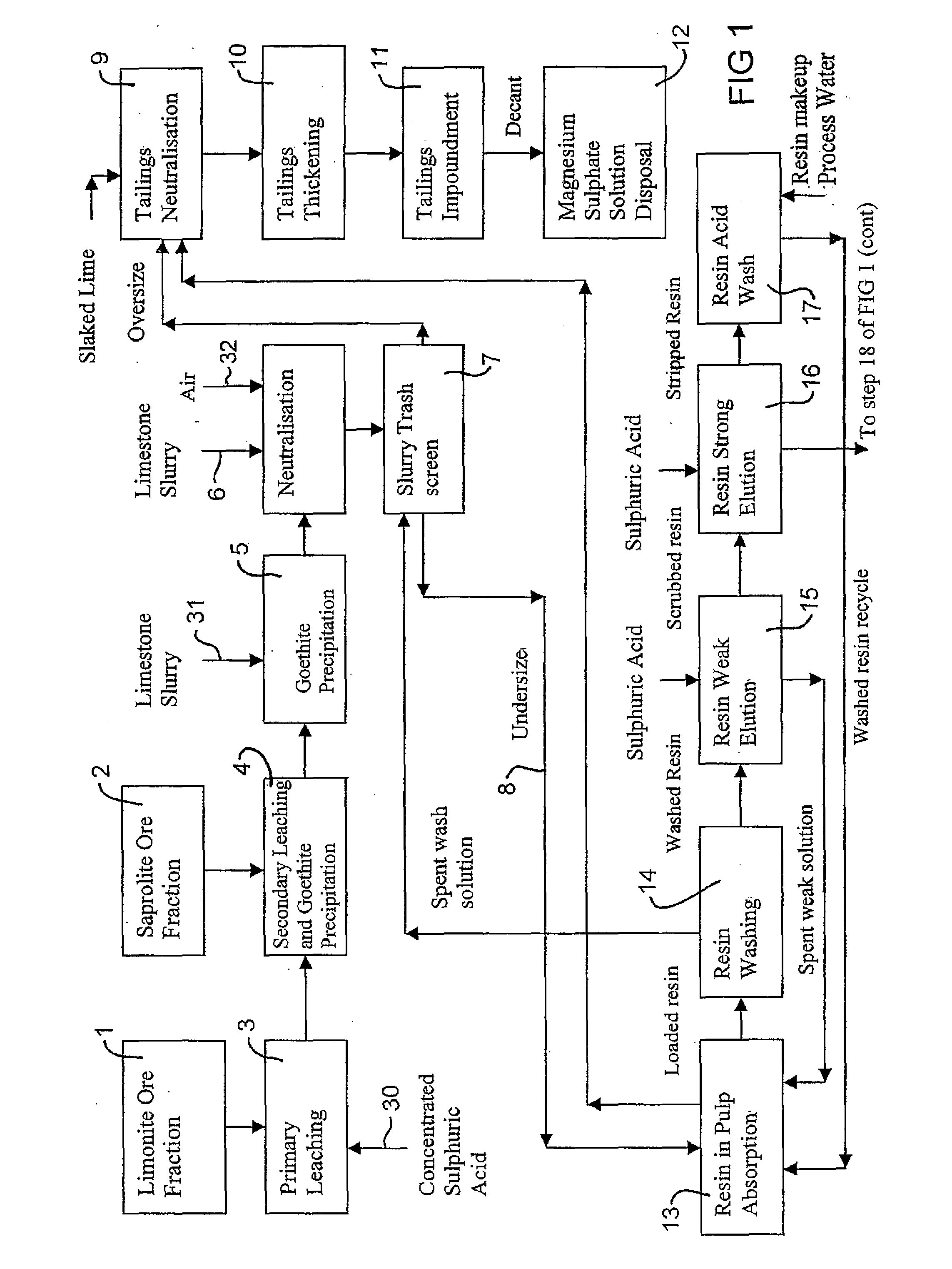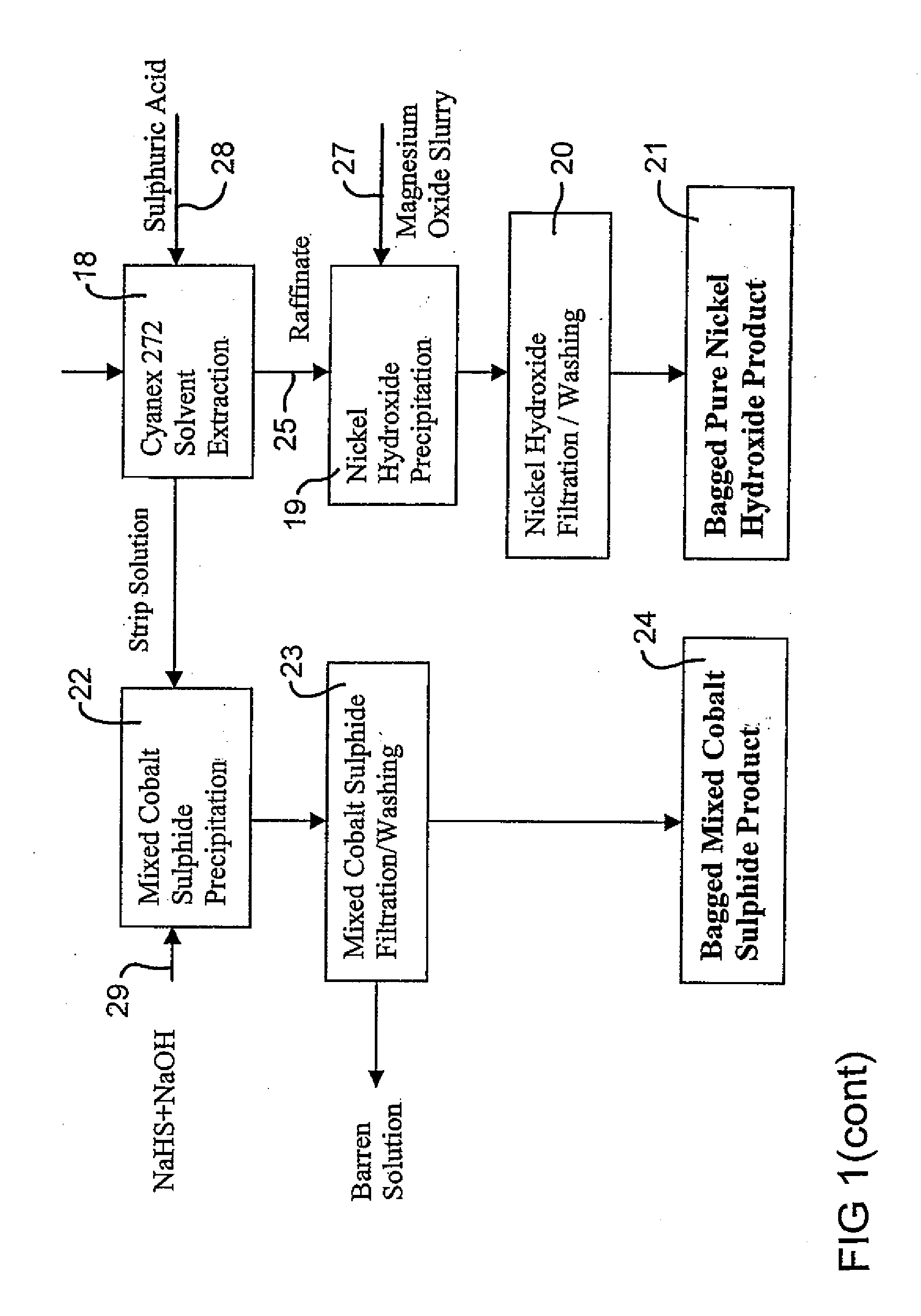Extraction of Nickel and Cobalt from a Resin Eluate Stream
a technology of resin eluate and nickel and cobalt, which is applied in the preparation of cobalt compounds, nickel oxides/hydroxides, nickel compounds, etc., can solve the problems of large amount of precipitated iron, large ccd process, and high processing cost, and achieves convenient transportation, large capital expenditure saving, and easy removal
- Summary
- Abstract
- Description
- Claims
- Application Information
AI Technical Summary
Benefits of technology
Problems solved by technology
Method used
Image
Examples
example 1
[0068] A sample of slurry from the High Pressure Acid leach (HPAL) of a lateritic nickel ore was neutralised and screened in order to be treated by a resin-in-pulp (RIP) treatment process.
[0069] 15 L of HPAL pulp slurry was placed in a 20-litre drum and stirred with an overhead stirrer. The pulp slurry was adjusted to pH 4.5 by adding limestone slurry. After neutralisation, the ORP of the pulp was adjusted to 300-400 mV. by the addition of a 20% sodium metabisulfite solution.
[0070] The pulp was then screened to 212 microns, and oversize material discharged. Pulp passed through 212-micron screen was collected and used in the RIP circuit. The screened and neutralised pulp was brought to a temperature of 50° C. and continuously added into a ten stage RIP pilot plant to contact a Clean TeQ R604 resin. R604 is an ion exchange resin containing iminodiacetic acid groups. The nickel cobalt and other metals were adsorbed onto the resin. The resin was then separated from the pulp, and the m...
example 2
[0073] A synthetic solution that would simulate the eluate produced from the atmospheric pressure leaching of a laterite ore was prepared for testing. The solution was prepared by dissolving the sulfates of nickel, cobalt, copper, manganese, iron, and magnesium, together with calcium hydroxide and sodium chloride in water, and maintaining the solution under a nitrogen atmosphere to prevent oxidation. It was then subjected to neutralisation by adjusting the pH to 4.5 by the addition of calcium carbonate, allowed to settle and the clear solution decanted to become the feed solution for the tests. The solution analysis before and after the neutralisation step are shown in Table 3.
TABLE 3Concentration (ppm)SolutionpHFe(II)CuZnCoNiMnMgCaNaClPrepared solution2.35832902323,22635,295318156649115.9Feed solution(after4.55532652413,25135,221313357463715.7—neutralization)
[0074] A solvent extraction pilot plant consisting of 10 water-jacketed mixer-settlers, was used to conduct counter current...
example 3
[0077] The objective of the semi continuous scrubbing test was to maximise the scrubbing of the loaded organic solution to remove the co-extracted Ni, Mg and Ca.
[0078] The loaded organic solution from a series of semi continuous extraction tests similar to Example 1 was combined and used for the semi continuous scrubbing tests. The parameters varied were controlled pH (5.4 and 5.6 by the addition of sulfuric acid), number of stages (1 and 2 stages) and scrub solution (solutions 1 and 2) and a temperature of 40° C.
[0079] A synthetic scrub solution was prepared to simulate a diluted solution from the strip liquor. A typical result from the semi continuous scrubbing is summarised in Tables 5. The Ni scrub efficiency was in the range of 90-93% with 38-53 ppm Ni left in the organic solution.
[0080] The higher concentration of Co, Cu, Mn and Zn in the scrub solution did not affect the scrubbing efficiency and one stage of scrubbing gave much lower Ni scrub efficiency (77.8%) and higher ...
PUM
| Property | Measurement | Unit |
|---|---|---|
| Density | aaaaa | aaaaa |
| Fraction | aaaaa | aaaaa |
| Fraction | aaaaa | aaaaa |
Abstract
Description
Claims
Application Information
 Login to View More
Login to View More - R&D
- Intellectual Property
- Life Sciences
- Materials
- Tech Scout
- Unparalleled Data Quality
- Higher Quality Content
- 60% Fewer Hallucinations
Browse by: Latest US Patents, China's latest patents, Technical Efficacy Thesaurus, Application Domain, Technology Topic, Popular Technical Reports.
© 2025 PatSnap. All rights reserved.Legal|Privacy policy|Modern Slavery Act Transparency Statement|Sitemap|About US| Contact US: help@patsnap.com



